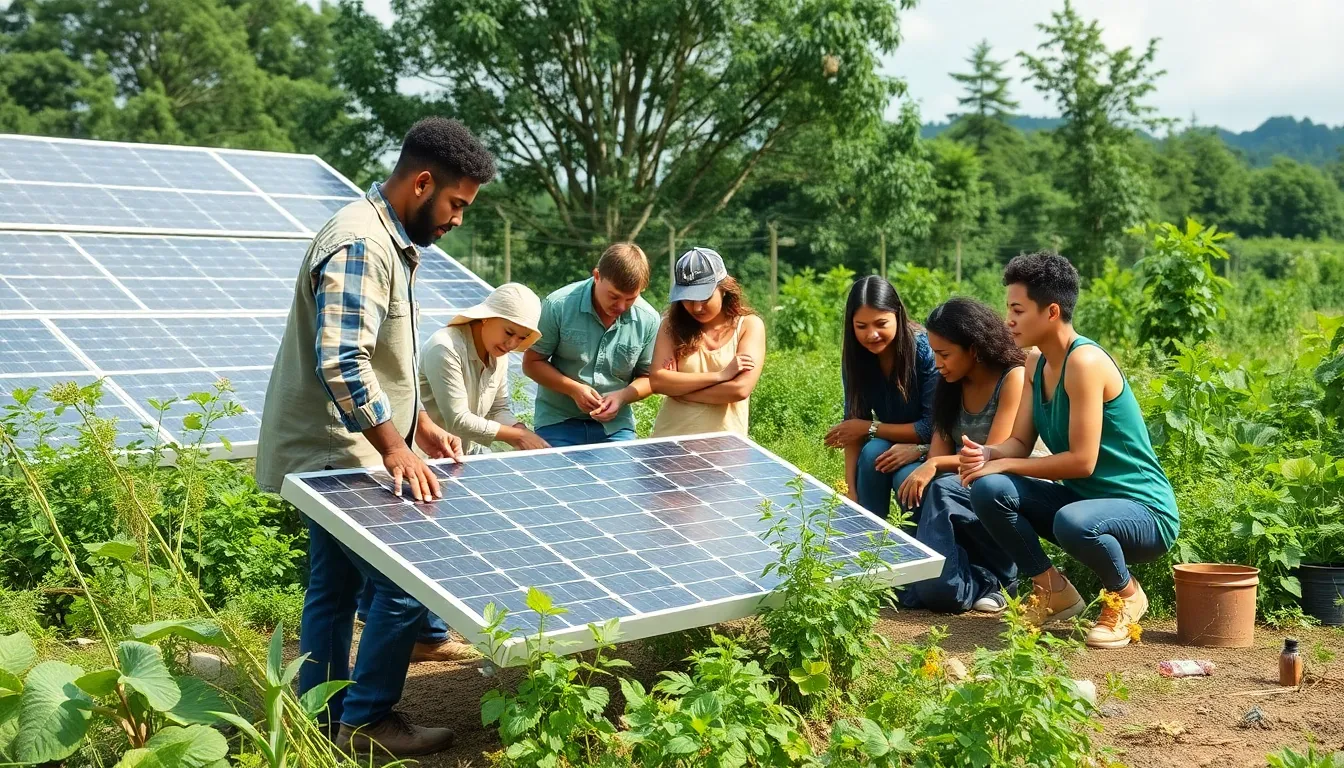As the world grapples with climate change and environmental degradation, green technology emerges as a beacon of hope. This innovative field focuses on developing sustainable solutions that minimize environmental impact while enhancing efficiency. From renewable energy sources to eco-friendly materials, green technology is revolutionizing the way industries operate.
Businesses and consumers alike are increasingly recognizing the importance of adopting green practices. By harnessing advancements in technology, society can move toward a more sustainable future. The shift not only helps preserve the planet but also drives economic growth and creates new job opportunities. Understanding the potential of green technology is crucial for anyone looking to make informed choices in today’s rapidly evolving landscape.
Table of Contents
ToggleOverview of Green Technology
Green technology encompasses methods and materials that promote sustainable practices and reduce environmental impact. This innovative field integrates renewable energy sources, such as solar, wind, and hydroelectric power, to promote efficiency. Green technology also includes the development of eco-friendly materials that minimize carbon footprints, such as biodegradable plastics and sustainable textiles.
Organizations across various sectors increasingly implement green technology solutions. For example, businesses adopt energy-efficient systems to decrease operational costs while reducing emissions. Moreover, cities incorporate smart grid technology to enhance energy distribution and optimize resource use.
The drive towards green technology aligns with global initiatives aimed at combating climate change. Governments, businesses, and individuals recognize the value of adopting sustainable practices. For instance, countries committing to net-zero emissions by specific target years prioritize investments in green innovations.
Industries such as agriculture utilize green technology by integrating precision farming techniques. These methods enhance crop yields while preserving water resources. Sustainable agriculture practices also include using organic farming and agroforestry to improve biodiversity.
As consumers become more environmentally conscious, the demand for green products rises. Companies respond by offering sustainable alternatives, reinforcing the importance of green technologies in today’s market. This increasing awareness shapes the future of production and consumption, emphasizing the role of green technology in creating a sustainable economy.
Importance of Green Technology

Green technology plays a crucial role in fostering environmental sustainability and driving economic growth. This innovative field not only minimizes ecological impacts but also paves the way for efficient resource utilization.
Environmental Benefits
Green technology significantly reduces greenhouse gas emissions, which mitigates climate change. Renewable energy sources like solar and wind power produce little to no emissions compared to fossil fuels. Eco-friendly materials, such as biodegradable plastics, decrease plastic pollution, benefiting ecosystems. Energy-efficient systems minimize energy consumption, leading to reduced demand for nonrenewable resources. Additionally, practices like precision farming enhance land use, preserving biodiversity and improving soil health. Together, these advancements foster a healthier planet.
Economic Advantages
Green technology drives cost savings and boosts profitability for businesses. Implementing energy-efficient systems lowers utility bills, improving financial performance. The growing market for eco-friendly products creates new job opportunities, with over 11 million jobs projected globally in renewable energy sectors by 2030. Investments in green technologies enhance competitive advantage, meeting consumer demand for sustainability. As governments offer incentives for adopting green practices, companies position themselves favorably in an evolving market. Overall, green technology not only contributes to environmental conservation but also propels economic innovation and growth.
Types of Green Technology
Green technology consists of various methods and systems that support sustainable practices. The primary types include renewable energy sources, energy efficiency technologies, and sustainable transportation solutions.
Renewable Energy Sources
Renewable energy sources harness natural processes to generate energy sustainably. Key examples include:
- Solar Power: This technology converts sunlight into electricity using photovoltaic cells, reducing reliance on fossil fuels.
- Wind Power: Wind turbines capture wind energy and convert it into electricity, providing a clean, renewable alternative.
- Hydropower: Hydropower utilizes flowing water to generate electricity, offering a reliable energy source with minimal emissions.
- Geothermal Energy: This approach taps into the Earth’s internal heat, providing a constant energy supply that remains unaffected by weather conditions.
- Bioenergy: Bioenergy harnesses organic materials such as plants and waste to produce fuel, heat, or electricity, contributing to waste reduction.
Energy Efficiency Technologies
Energy efficiency technologies focus on minimizing energy consumption while maintaining performance. Notable examples include:
- LED Lighting: These lights consume less energy than traditional bulbs, significantly reducing energy costs and extending lifespan.
- Smart Thermostats: Smart thermostats optimize heating and cooling schedules, leading to reduced energy waste in residential and commercial buildings.
- Energy-efficient Appliances: Appliances like refrigerators and washing machines that meet Energy Star standards use less energy than conventional models.
- Insulation Materials: Advanced insulation techniques help retain heat in winter and keep buildings cool in summer, lowering heating and cooling needs.
- Building Automation Systems: These systems streamline energy management in commercial spaces, improving operational efficiency and reducing waste.
Sustainable Transportation
Sustainable transportation emphasizes reducing environmental impact while improving mobility. Prominent examples include:
- Electric Vehicles (EVs): EVs produce lower emissions compared to gasoline-powered vehicles, especially when charged with renewable energy.
- Public Transit Systems: Efficient public transport networks reduce individual car use, lowering traffic congestion and emissions.
- Carpooling and Ridesharing: These services promote shared travel, decreasing the number of vehicles on the road and associated emissions.
- Bicycle Infrastructure: Developing bike lanes and bike-sharing programs encourages cycling as an eco-friendly transport option.
- Alternative Fuels: Vehicles powered by biofuels, hydrogen, or compressed natural gas reduce reliance on oil and decrease greenhouse gas emissions.
Each type of green technology contributes significantly to fostering sustainability and reducing environmental impact, aligning with global efforts to combat climate change.
Challenges in Implementing Green Technology
Implementing green technology faces significant challenges that can hinder its broader adoption. Key obstacles include economic barriers and technological limitations.
Economic Barriers
Economic barriers significantly impede the adoption of green technology. High upfront costs associated with renewable energy systems, energy efficiency upgrades, and sustainable materials pose immediate financial challenges for businesses and consumers. Existing infrastructure investments further complicate transitioning to green technologies, as organizations may resist shifting from well-established systems. Government incentives and subsidies can alleviate some financial pressure, yet accessing these resources often proves difficult and varies by region. Despite benefits like long-term savings and job creation, the initial financial burden deter many potential adopters.
Technological Limitations
Technological limitations also hamper the implementation of green technology. Current renewable energy sources, while effective, may lack efficiency or dependability in certain geographical regions. Energy storage technologies, essential for managing intermittent energy supply from sources like solar and wind, require ongoing development to enhance reliability. Furthermore, the complexity of integrating new technologies with existing systems leads to increased costs and extended implementation timelines. As research progresses, he hopes to overcome these technological hurdles, promoting widespread adoption of green solutions essential for a sustainable future.
Future Trends in Green Technology
Emerging trends in green technology reflect ongoing innovation in the pursuit of sustainability. Key developments focus on enhancing energy efficiency, expanding renewable energy integration, and adopting advanced materials.
1. Enhanced Renewable Energy Technologies
Enhanced renewable energy technologies aim to improve efficiency and reduce costs. Solar panel efficiency rates exceed 20% due to advances in materials like perovskite, boosting energy capture. Wind turbines with larger blades and advanced materials increase energy output, lowering reliance on fossil fuels.
2. Smart Grids and Energy Management
Smart grids enable real-time monitoring and management of energy resources. These systems optimize energy distribution and reduce waste through demand response capabilities. Implementing energy management systems in buildings lowers operating costs by 10%-30% while enhancing energy efficiency.
3. Electrification of Transportation
Electrification of transportation is accelerating with electric vehicle adoption. In 2022, global electric vehicle sales reached 10 million, marking a 28% increase from the previous year. Investments in charging infrastructure support this shift, bolstering low-emission mobility solutions.
4. Circular Economy Practices
Circular economy practices focus on reducing waste and promoting resource efficiency. Companies are increasingly adopting designs that facilitate recycling and reuse. A report indicates that implementing circular economy strategies could generate $4.5 trillion in economic benefits by 2030.
5. Biodegradable and Eco-Friendly Materials
The rise of biodegradable and eco-friendly materials contributes to reduced environmental impact. Bioplastics and sustainable textiles offer alternatives to conventional resources, lowering pollution levels. Numerous brands are incorporating these materials into their products to meet consumer demand.
6. Innovations in Carbon Capture
Innovations in carbon capture technology advance the fight against climate change. Systems designed to capture CO2 emissions from industrial processes show promising results in reducing atmospheric carbon levels. Several pilot projects aim to demonstrate efficacy at scale.
7. Investment in Sustainable Agriculture
Investment in sustainable agriculture technologies enhances food production while preserving ecosystems. Precision agriculture techniques, such as drone monitoring and soil sensors, boost crop yields by up to 20%. Sustainable practices also support biodiversity and minimize water usage.
8. Green Building and Construction
Green building practices incorporate eco-friendly materials and energy-efficient designs. New regulations promote sustainable construction methods, reducing waste and enhancing energy performance. LEED-certified buildings can achieve energy savings of 30%-50% compared to traditional structures.
These future trends identify the continuing evolution of green technology, underscoring its critical role in fostering a sustainable environment and addressing global challenges.
Green technology is reshaping the landscape of sustainability and economic growth. Its innovative approaches not only address pressing environmental issues but also create new opportunities in various sectors. As businesses and consumers increasingly prioritize sustainable practices, the demand for green solutions continues to rise.
Investments in renewable energy, energy efficiency, and sustainable transportation are critical to building a resilient future. While challenges in implementation persist, ongoing advancements and commitment to green technologies will pave the way for a more sustainable world. The journey toward a greener economy is underway, and it promises to enhance both environmental health and economic vitality.



